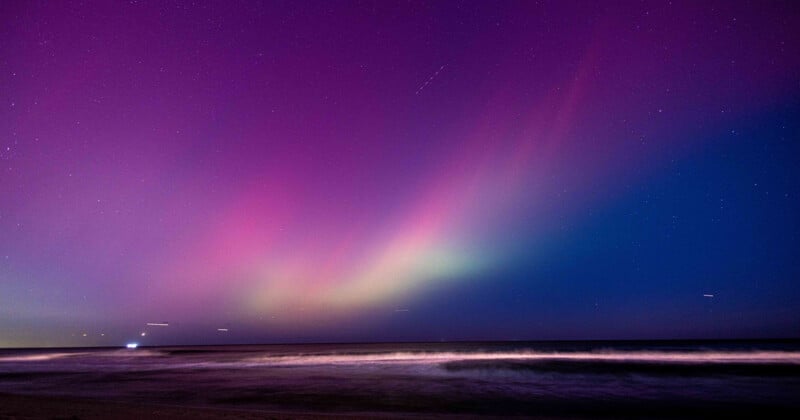Last Night’s Aurora Borealis Delivered an Amazing Show for Photographers

The northern lights were visible across most of the northern United States, Canada and Europe last night in a rare widespread appearance thanks to a massive solar storm.
The night sky was brighter than usual for a good chunk of the northern hemisphere last night due to the Aurora Borealis being visible much farther south than normal. The aurora’s rare appearance was notably seen by residents of the New York City/New Jersey area, Chicago, and California; with sightings reported from as far south as Texas and all around the world.
Post by @jkputnamphotoView on Threads
Post by @nightlightsfilmsView on Threads
As PetaPixel wrote earlier this week, the National Oceanic and Atmospheric Administration’s (NOAA) Space Weather Prediction Center (SWPC) has been monitoring a “X-Class” solar flare and coronal mass ejection (CME), which caused NOAA to release a Severe G4 Geomagnetic Storm Watch alert.
From Long Island, NY, the Aurora this evening.
Caused by charged solar particles arriving at Earth from yesterday's solar flare. They slam into atmospheric molecules of Oxygen and Nitrogen, rendering them a-glow. Here, Red and Green are visible, with the Big Dipper looking on. pic.twitter.com/wgzCIiJUHu
— Neil deGrasse Tyson (@neiltyson) October 11, 2024
Even Neil deGrasse Tyson shared a photo of the aurora last night. Naturally, always finding time for a science lesson, Tyson explains just why the aurora does what it does.
“Caused by charged solar particles arriving at Earth from yesterday’s solar flare,” Tyson wrote. “They slam into atmospheric molecules of Oxygen and Nitrogen, rendering them a-glow. Here, Red and Green are visible, with the Big Dipper looking on.”
The result was a brilliant show for thousands of people who normally live outside of the aurora’s typical area, and photographers from all around the world reveled in the opportunity to capture the event. Many posted photos on social media platforms like Threads and X throughout the night.
Post by @jacklodgephotographyView on Threads
The Northern Lights really put its Heart into tonight’s Spectacular display.#aurora #Auroraborealis #northernlights pic.twitter.com/w3qHHqevKd
— Karl McCarthy (@McCarthyKarl) October 11, 2024
The effects of the solar storm are still possible to be seen throughout the weekend. According to the NOAA forecast, most of Canada and Alaska should get a good show, but even states like Idaho, the Dakotas, Minnesota, and Wisconsin should also be able to see it.
My favourite image I’ve ever taken. The peak of last night’s historic aurora display over Poolbeg Lighthouse.
Looks like a serious Photoshop job but is very much real. Going to need to print this seriously large. pic.twitter.com/RUo44CSSmH
— Sryan Bruen Photography (@sryanbruenphoto) October 11, 2024
Tonight’s aurora lights over New York City pic.twitter.com/bAV0hKUrUr
— Max Guliani (@maximusupinNYc) October 10, 2024
What happened last night is something that I thought was only a dream. The strongest aurora ever, above the Dutch windmills. I still can't believe this was real. Captured after midnight in The Netherlands. pic.twitter.com/eXyyRe3JW8
— Albert Dros (@albertdrosphoto) May 11, 2024
For photographers in those areas trying to get a shot off during this rare event, PetaPixel has a guide for taking photos of the northern lights.